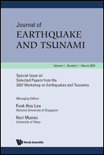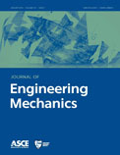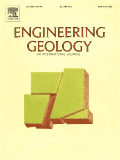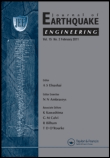
Journal of Earthquake and Tsunami
Scope & Guideline
Innovating research on earthquakes and tsunamis.
Introduction
Aims and Scopes
- Seismic Analysis and Performance Evaluation:
The journal publishes studies that assess the seismic performance of various structures, including buildings, bridges, and tunnels, using experimental, numerical, and analytical methods. - Tsunami Hazard Assessment and Mitigation:
Research on tsunami dynamics, hazard assessment, and mitigation strategies is a core focus, including studies on wave interactions with structures and land. - Innovative Engineering Solutions:
The journal highlights innovative engineering solutions for seismic and tsunami resilience, including the development of new materials, structural designs, and retrofitting techniques. - Risk Assessment and Management:
Papers addressing risk assessment methodologies, including probabilistic approaches to seismic hazard analysis and multi-hazard risk assessments, are prominently featured. - Interdisciplinary Approaches:
The journal encourages interdisciplinary research that integrates geophysics, engineering, urban planning, and environmental science to address earthquake and tsunami challenges. - Advanced Computational Methods:
Research utilizing advanced computational techniques, such as machine learning, deep learning, and numerical simulations, is a significant aspect of the journal's contributions.
Trending and Emerging
- Machine Learning and AI Applications:
There is a growing trend towards utilizing machine learning and artificial intelligence for predictive modeling, early warning systems, and damage assessment in seismic and tsunami research. - Resilience and Recovery Strategies:
Research focusing on resilience planning and recovery strategies for communities affected by earthquakes and tsunamis is gaining traction, highlighting the importance of sustainable practices in disaster management. - Interdisciplinary Hazard Assessments:
Emerging studies are increasingly adopting interdisciplinary approaches to assess the combined effects of seismic and tsunami hazards, integrating environmental, social, and economic factors. - Smart Infrastructure and IoT Integration:
The integration of smart technologies and IoT in infrastructure design and disaster response is an emerging theme, reflecting advancements in real-time monitoring and data collection. - Climate Change Impacts on Seismic and Tsunami Risks:
Research exploring the interplay between climate change and seismic/tsunami risks is on the rise, indicating a growing awareness of how environmental changes can exacerbate natural disasters.
Declining or Waning
- Purely Theoretical Studies:
There has been a noticeable decline in papers focused solely on theoretical models without practical application or validation, as the journal increasingly favors studies with empirical data and real-world applicability. - Basic Seismic Monitoring Techniques:
Research centered on traditional seismic monitoring techniques, without innovations or enhancements, has decreased, suggesting a shift towards more advanced and integrated monitoring systems. - Historical Seismicity Studies:
The frequency of papers focusing on historical seismicity and retrospective analyses has diminished, possibly due to a growing emphasis on real-time data analysis and predictive modeling. - Localized Tsunami Studies:
Studies that focus narrowly on localized tsunami events without broader implications or regional contexts are becoming less frequent, reflecting a trend towards comprehensive, multi-regional analyses. - Static Structural Assessment:
There is a waning interest in static assessments of structures under seismic loads, with more emphasis now placed on dynamic responses and time-dependent analyses.
Similar Journals

JOURNAL OF ENGINEERING MECHANICS
Exploring the Mechanics of Tomorrow, TodayJOURNAL OF ENGINEERING MECHANICS, published by the ASCE - American Society of Civil Engineers, stands as a premier interdisciplinary journal in the field of engineering mechanics. With an impact factor reflecting its vital contributions—placing it in the Q1 category for both Mechanical Engineering and Mechanics of Materials—this journal has established itself as a critical resource for researchers and professionals alike. Since its inception in 1981 and continuing through 2024, it has provided a platform for the dissemination of high-quality research, emphasizing innovative methodologies and cutting-edge findings. The journal's ranking in Scopus further underscores its significance, with impressive standings in the 79th and 77th percentiles of its respective categories. As a vital resource for students and professionals aiming to stay abreast of developments in engineering mechanics, it remains committed to fostering rigorous scientific exploration and practical applications within the field.

Ingegneria Sismica
Elevating engineering practices for safer structures.Ingegneria Sismica, a premier journal published by PATRON EDITORE S R L, serves as an essential platform for the dissemination of research in the fields of building and construction, geotechnical engineering, and safety risk management. With a focus on earthquake engineering and structural safety, the journal has established itself as a prominent source of knowledge since its inception in 2010. The journal holds an impressive Q2 classification in multiple categories, including Building and Construction and Geotechnical Engineering, reflecting its significant impact within these disciplines. Despite its Italian roots, it appeals to an international audience of researchers, professionals, and students dedicated to advancing the understanding of seismic resilience and risk mitigation strategies. Although open access is not currently available, the potential for knowledge sharing and innovative methodologies presented in the articles continues to attract a robust readership. With its commitment to excellence and relevance, Ingegneria Sismica is poised to shape future discourse in engineering practices aimed at enhancing safety, reliability, and quality within seismic zones.

Geodynamics & Tectonophysics
Unraveling the Mysteries of Geodynamics and TectonicsGeodynamics & Tectonophysics, published by the esteemed Russian Academy of Sciences, Siberian Branch, Inst Earths Crust, is a pivotal open-access journal that has been contributing to the scientific discourse on Earth's dynamic processes since 2010. With an ISSN of 2078-502X, this journal serves as a vital platform for researchers and professionals interested in the fields of Earth-Surface Processes, Economic Geology, Geology, and Geophysics, holding a Q3 ranking in each of these categories as of 2023. The journal is based in Irkutsk, Russia, and encompasses a broad spectrum of topics, fostering interdisciplinary collaboration and innovation. Researchers can access cutting-edge studies and insights, engaging with a community committed to advancing our understanding of geodynamics and tectonic phenomena. With a sustained commitment to quality and accessibility, Geodynamics & Tectonophysics plays a critical role in addressing pressing geological concerns and advancing global geological research.

CHINESE JOURNAL OF GEOPHYSICS-CHINESE EDITION
Elevating Understanding of Earth's DynamicsCHINESE JOURNAL OF GEOPHYSICS-CHINESE EDITION, published by SCIENCE PRESS, stands as a prominent platform for the dissemination of cutting-edge research in the fields of Geophysics and Geochemistry. Since its inception in 1979, this esteemed journal has successfully converged a wealth of knowledge, boasting a substantial impact factor and a recognized standing within the academic community, evidenced by its Q2 categorization in both Geochemistry and Petrology and Geophysics as of 2023. Researchers, professionals, and students looking to stay abreast of the latest advancements in solid-earth sciences will find the journal's comprehensive articles and studies invaluable. Based in Beijing, China, the journal emphasizes a broad scope, encompassing various aspects of geophysical research and methodologies. Although it does not currently offer open access options, its commitment to quality research makes it a crucial resource for the scientific community.

GEOPHYSICAL JOURNAL INTERNATIONAL
Exploring Geophysical and Geochemical InnovationsGEOPHYSICAL JOURNAL INTERNATIONAL, published by the esteemed Oxford University Press, stands as a premier platform for advancing research in the realms of Geophysics and Geochemistry. With a rich history spanning from 1922 to 2024, this journal not only adheres to the highest scholarly standards but has also achieved remarkable recognition, evidenced by its impressive ranking in the Scopus database—#32 in Geophysics and #48 in Geochemistry and Petrology, placing it within the top quartiles of its field. Researchers and professionals will appreciate its comprehensive scope and commitment to disseminating vital research findings, which significantly contribute to our understanding of the Earth's processes. Although it does not offer open access, the journal's Q1 quartile status underscores its influence and importance in shaping contemporary scientific discourse. Whether you are a seasoned researcher or a budding student, GEOPHYSICAL JOURNAL INTERNATIONAL is an indispensable resource for essential knowledge and groundbreaking studies in the geophysical sciences.

ENGINEERING GEOLOGY
Advancing the Intersection of Geology and EngineeringENGINEERING GEOLOGY, published by Elsevier, is a leading journal in the fields of Geology and Geotechnical Engineering, recognized by its prestigious Q1 ranking in both categories for 2023. With a deep focus on the application of geological principles to engineering practices, this journal plays a vital role in advancing knowledge and methodologies that enhance infrastructure development and environmental sustainability. Operating since 1965, the journal disseminates high-quality research, offering insights that foster innovation in geotechnical assessments and geological hazard evaluation. Researchers and professionals benefit from its rigorous peer-review process and impactful studies, bolstered by a strong Scopus ranking - #4 in Geology and #3 in Geotechnical Engineering, both placing it in the top 2% of its field. Although there is no Open Access option available, the journal facilitates significant academic discourse, making it an essential resource for anyone involved in the intersection of geology and engineering.

JOURNAL OF EARTHQUAKE ENGINEERING
Pioneering research for resilient structures.JOURNAL OF EARTHQUAKE ENGINEERING, published by TAYLOR & FRANCIS LTD, stands as a pivotal resource in the fields of Building and Construction, Civil and Structural Engineering, and Geotechnical Engineering. With an impressive Q1 ranking in multiple categories for 2023, this journal is instrumental for researchers, professionals, and students committed to advancing knowledge in earthquake engineering and its practical applications. As a platform that spans the years from 1997 to 2024, it highlights significant contributions to safety, risk, reliability, and quality in engineering practices. While the journal operates on a subscription basis, its highly regarded articles, bolstered by robust Scopus rankings—such as rank #46 in Building and Construction—underscore its credibility and influence in shaping standards and methodologies within the discipline. Promoting innovative and evidence-based approaches, the JOURNAL OF EARTHQUAKE ENGINEERING is essential reading for anyone engaged in the science and technology of earthquake-resistant structures.

Earthquake Science
Exploring the Depths of Seismic ScienceEarthquake Science is a prominent open access journal that has been serving the scientific community since its inception in 2009, published by KEAI PUBLISHING LTD. With an ISSN of 1674-4519 and an E-ISSN of 1867-8777, this journal has established itself as a significant platform for the dissemination of research in the fields of geology, geophysics, and geotechnical engineering, evident from its Q2 ranking in 2023 across these categories. Based in China, Earthquake Science aims to facilitate knowledge sharing and foster interdisciplinary collaboration by publishing a range of high-quality articles, reviews, and research papers demonstrating advancements in understanding seismic activity and its impacts. Its commitment to open access since 2015 ensures that valuable insights are available to researchers, professionals, and students globally, thereby supporting critical inquiries into earthquake mechanisms and risk management strategies. Explore the latest findings and contribute to the ongoing conversation in the evolving landscape of earthquake science.

Earthquakes and Structures
Building a safer future with cutting-edge earthquake engineering.Earthquakes and Structures is a prestigious academic journal published by TECHNO-PRESS, dedicated to the field of Civil and Structural Engineering. Since its inception in 2010, this journal has provided a platform for innovative research and practical applications, addressing critical challenges related to seismic activities and their impact on infrastructure. With an ISSN of 2092-7614 and an E-ISSN of 2092-7622, it is indexed in top databases, reflecting its commitment to quality and relevance, as indicated by its Q3 quartile ranking in 2023. The journal encompasses a wide range of topics, from theoretical investigations to real-world case studies, appealing to researchers, professionals, and students alike. By fostering interdisciplinary collaboration and disseminating cutting-edge findings, Earthquakes and Structures plays an essential role in advancing knowledge and practices in earthquake engineering, enhancing global resilience against seismic threats.

EARTHQUAKE SPECTRA
Innovative insights into seismic phenomena and engineering.EARTHQUAKE SPECTRA, published by SAGE PUBLICATIONS INC, is a premier journal dedicated to the field of geophysics, geotechnical engineering, and engineering geology, with a specific focus on seismic phenomena. Issued both in print (ISSN: 8755-2930) and electronically (E-ISSN: 1944-8201), the journal has maintained its position as a leading source of high-quality research since its inception in 1984. Recognized in the 2023 Category Quartiles as Q1 in both geophysics and geotechnical engineering, it is highly regarded in the academic community, ranking 11 out of 165 in its field, placing it in the 93rd percentile of Earth and Planetary Sciences, and 30 out of 229 for geotechnical engineering with an 87th percentile standing. With a commitment to advancing knowledge and practice in earthquake engineering, EARTHQUAKE SPECTRA publishes original research, case studies, and critical reviews that inform the design and construction practices related to seismic events. Although it does not currently offer open access, the journal's impact on the discipline remains significant, making it an essential resource for researchers, professionals, and students dedicated to understanding and mitigating the effects of earthquakes.